New Discoveries at Gurugyam Cemetery and Chu vthag Cemetery in Ngari, Tibet
From:Chinese Archaeology NetWriter:Date:2015-02-02
From 2012 to 2014, excavations have been conducted to the Gurugyam Cemetery and Chu vthag Cemetery in the upper reaches of the glang-chen gtsang-po River in Ngari, Tibet, jointly by the Institute of Archaeology, CASS and the Tibetan Institute for Conservation and Research of Cultural Relics. A group of cave burials and pit burials have been uncovered, yielding a great deal of valuable materials.
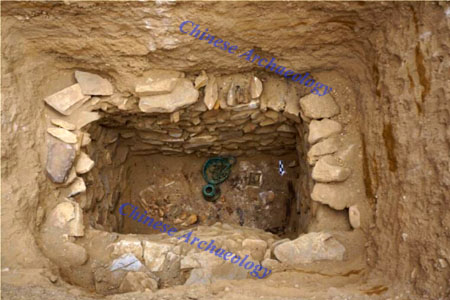
tomb M1 at Gurugyam Cemetery
At the Gurugyam Cemetery, which is located in Gar County, 11 tombs with varying sizes have been excavated, including 8 burials from the Zhangzhung period and 3 from the Tubo period. Those from Zhangzhung period are all pit burials with cists on the bottom. Most of them are secondary burials. The bodies are placed lying on one side in a flexed position. The largest burials, all over 5 m in depth and containing several human skeletons, have complex structures due to have being opened for multiple times in the history. In the filling earth are buried human and animals bones which could serve sacrificial rite. Some burials have woods to support the stone ceilings and use wooden caskets to contain bodies showing a higher rank of the tomb occupant, because woods are quite rare resource on the high plateau. The burials yield silks, golden death masks, gilt bronzes, silvers, irons, potteries, beads and massive human and animal bones.
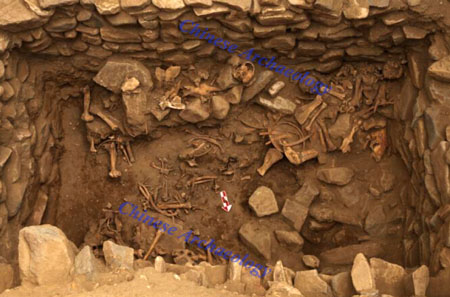
tomb M2 at Gurugyam Cemetery
According to C14 dating, 8 burials of the Gurugyam Cemetery are dated back to 1800-1700 BP, that is, the 2nd -3rd century AD, a period recorded as the Zhangzhung Kingdom period in west Tibet. The burial’s forms, sizes, and the burial objects indicate some of them are belong to nobility of Zhangzhung tribes.
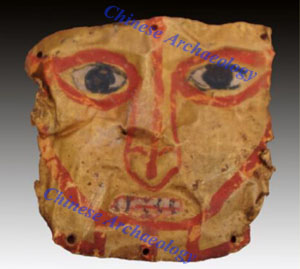
gold mask from tomb M1 at Gurugyam Cemetery
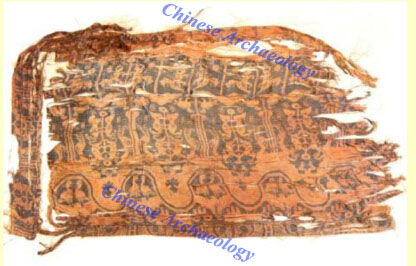
unearthed brocade from tomb M1 at Gurugyam Cemetery
3 smaller tombs dating back to the Tubo period have smaller cists, which are enclosed with stone slabs. The bodies are placed in a flexed position. The burial objects are quite rare except many glass beads have been found. However, the findings are important because they inform us that the regional funerary custom sustained after the region annexed by the Tubo Empire.
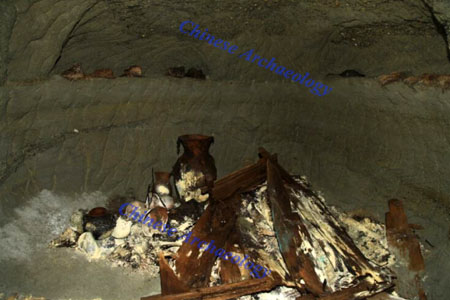
photo of burial chamber of M2 at Chu vthag Cemetery
The Chu vthag Cemetery is located in Zanda County. In 2014 archaeologists found 5 cave burials lying in a line on a hill slope. The burial has a rectangular-shaft-shaped passage, about 5 m in depth. In the middle there is a platform (ercengtai) covered with stone plates, separating the passage into the upper and lower two parts. The upper part is filled with pebbles and earth while the lower part, due to the protection of the stone plates, is empty. On the bottom of the passage a cave with arched shaped entrance is dug to the narrow side. The cave has one or two chambers. All contain wooden coffins. The cave with two chambers contains more than one coffin, that is, a joint burial. Beside each coffin there is always a group of potteries in varying sizes and forms. In the coffins the human bones and some burial objects could be seen. The tomb occupants adopt flexed attitude. A great many animal bones including horses, sheep and goats are placed on the ground. Many objects for daily use are buried, including painted wooden trays, square wooden combs, handled bronze mirror, carved wooden plaques, wooden waving implements, rectangular wooden trays, rattan utensils, painted potteries and plentiful glass beads.
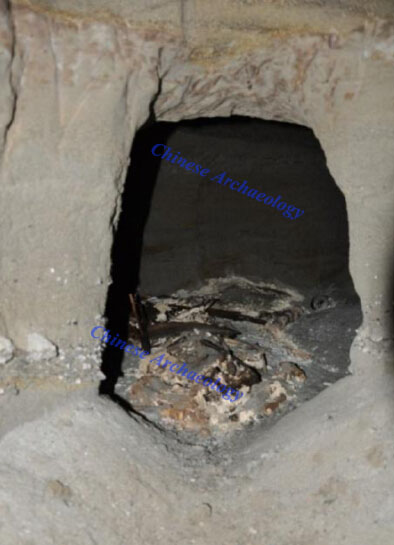
the entrance to the tomb M2 at Chu vthag Cemetery
The burials are dated to 1800 BP according to the C14 dating of the previous findings. It probably belongs to one tribe of the Zhangzhung period. Some burials indicate of possessing higher ranking. These cave burials are found in Ngari for the first time by archaeologists in their field excavation. The burial objects are quite rich in variety, providing valuable information for reconstructing the material life of ancient Zhangzhung tribes. The form of burials could be imitations of the real cave dwellings which were very prevalent during the Guge Kingdom period, and could be very helpful to rebuild the Zhangzhung architecture. The large amount of barley seeds and plenty of animal bones suggest the co-existence of husbandry and cultivation as well as the prosperity of economy.

unearthed pottery from tomb M3 at Chu vthag Cemetery
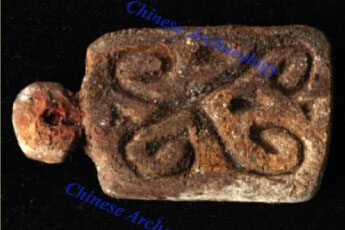
unearthed wooden plaques from tomb M3 at Chu vthag Cemetery
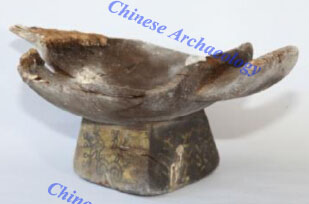
unearthed wooden tray from tomb M4 at Chu vthag Cemetery

unearthed glass beads from tomb M4 at Chu vthag Cemetery

